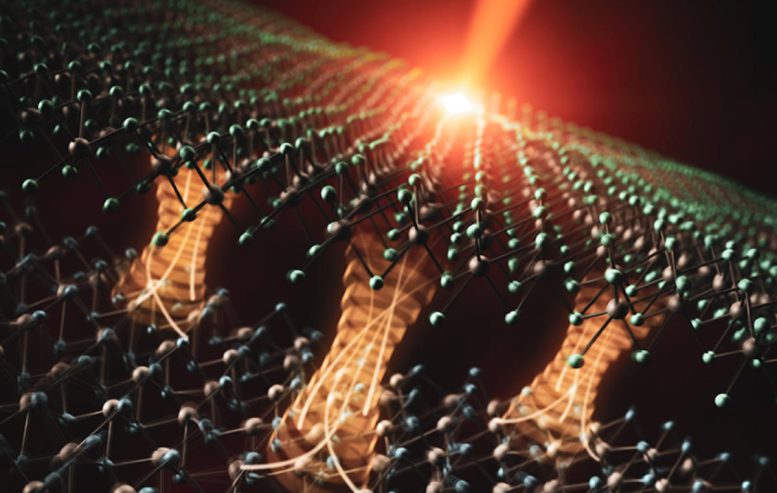
Creative depiction of electron move pushed by way of an ultrashort laser pulse, throughout an interface between two atomically-thin fabrics. This move is facilitated by way of an interlayer ‘bridge’ state that electrons are in a position to get right of entry to because of lattice vibrations in each fabrics. Credit score: Gregory M. Stewart/SLAC
An digital bridge facilitates the short move of power between semiconductors.
Contents
Researchers are exploring the possible programs of two-dimensional (2D) fabrics in transistors and optoelectronics, as semiconductor gadgets proceed to transform smaller. Controlling the glide of electrical energy and warmth in those fabrics is very important for his or her capability, however a deeper figuring out of those behaviors on the atomic scale is needed first.
Researchers have now discovered that electrons play a shocking position within the power move between layers of 2D semiconductor fabrics WSe2 and WS2. In spite of the layers now not being tightly bonded, electrons bridge the space and facilitate fast warmth move.

Berkeley Lab’s Archana Raja on the Molecular Foundry. Raja’s staff on the Molecular Foundry perfected the artwork of fabricating gadgets from two-dimensional semiconductors in an effort to discover the abnormal habits of electrons and warmth in those unique fabrics. Credit score: Marilyn Sargent/Berkeley Lab
“Our paintings presentations that we wish to transcend the analogy of Lego blocks to know stacks of disparate 2D fabrics, although the layers aren’t strongly bonded to each other,” mentioned Archana Raja, a scientist on the Division of Power’s Lawrence Berkeley Nationwide Laboratory (Berkeley Lab), who led the find out about.
“The reputedly distinct layers, actually, be in contact via shared digital pathways, permitting us to get right of entry to and in the end design homes which are more than the sum of the portions.”
The find out about seemed not too long ago in Nature Nanotechnology and combines insights from ultrafast, atomic-scale temperature measurements and intensive theoretical calculations.
“This experiment used to be motivated by way of elementary questions on atomic motions in nanoscale junctions, however the findings have implications for power dissipation in futuristic digital gadgets,” mentioned Aditya Sood, co-first creator of the find out about and these days a analysis scientist at Stanford College. “We had been fascinated with how electrons and atomic vibrations couple to each other when warmth flows between two fabrics. Through zooming into the interface with atomic precision, we exposed an incredibly environment friendly mechanism for this coupling.”
An ultrafast thermometer with atomic precision
The researchers studied gadgets consisting of stacked monolayers of WSe2 and WS2. The gadgets had been fabricated by way of Raja’s staff at Berkeley Lab’s Molecular Foundry, who perfected the artwork of the use of Scotch tape to raise off crystalline monolayers of the semiconductors, each and every not up to a nanometer in thickness. The usage of polymer stamps aligned beneath a home-built stacking microscope, those layers had been deposited on best of one another and exactly positioned over a microscopic window to allow the transmission of electrons during the pattern.

From left, Stanford College’s Aaron Lindenberg, Aditya Sood, and Felipe Jornada are some of the scientists who came upon a extremely environment friendly mechanism for power move between two-dimensional fabrics. Credit score: Jacqueline Ramseyer Orrell/SLAC Nationwide Accelerator Laboratory
In experiments performed on the Division of Power’s SLAC Nationwide Accelerator Laboratory, the crew used a method referred to as ultrafast electron diffraction (UED) to measure the temperatures of the person layers whilst optically thrilling electrons in simply the WSe2 layer. The UED served as an “electron digital camera”, taking pictures the atom positions within each layer. By varying the time interval between the excitation and probing pulses by trillionths of a second, they could track the changing temperature of each layer independently, using theoretical simulations to convert the observed atomic movements into temperatures.
“What this UED approach enables is a new way of directly measuring temperature within this complex heterostructure,” said Aaron Lindenberg, a co-author of the study at Stanford University. “These layers are only a few angstroms apart, and yet we can selectively probe their response and, as a result of the time resolution, can probe at fundamental time scales how energy is shared between these structures in a new way.”
They found that the WSe2 layer heated up, as expected, but to their surprise, the WS2 layer also heated up in tandem, suggesting a rapid transfer of heat between layers. By contrast, when they didn’t excite electrons in the WSe2 and heated the heterostructure using a metal contact layer instead, the interface between WSe2 and WS2 transmitted heat very poorly, confirming previous reports.
“It was very surprising to see the two layers heat up almost simultaneously after photoexcitation and it motivated us to zero in on a deeper understanding of what was going on,” said Raja.
An electronic “glue state” creates a bridge
To understand their observations, the team employed theoretical calculations, using methods based on density functional theory to model how atoms and electrons behave in these systems with support from the Center for Computational Study of Excited-State Phenomena in Energy Materials (C2SEPEM), a DOE-funded Computational Materials Science Center at Berkeley Lab.

Jonah Haber. Credit: Noman Paya
The researchers conducted extensive calculations of the electronic structure of layered 2D WSe2/WS2, as well as the behavior of lattice vibrations within the layers. Like squirrels traversing a forest canopy, who can run along paths defined by branches and occasionally jump between them, electrons in a material are limited to specific states and transitions (known as scattering), and knowledge of that electronic structure provides a guide to interpreting the experimental results.
“Using computer simulations, we explored where the electron in one layer initially wanted to scatter to, due to lattice vibrations,” said Jonah Haber, co-first author on the study and now a postdoctoral researcher in the Materials Sciences Division at Berkeley Lab. “We found that it wanted to scatter to this hybrid state – a kind of ‘glue state’ where the electron is hanging out in both layers at the same time. We have a good idea of what these glue states look like now and what their signatures are and that lets us say relatively confidently that other, 2D semiconductor heterostructures will behave the same way.”
Large-scale molecular dynamics simulations confirmed that, in the absence of the shared electron “glue state”, heat took far longer to move from one layer to another. These simulations were conducted primarily at the National Energy Research Scientific Computing Center (NERSC).
“The electrons here are doing something important: they are serving as bridges to heat dissipation,” said Felipe de Jornada, a co-author from Stanford University. “If we can understand and control that, it offers a unique approach to thermal management in semiconductor devices.”
Reference: “Bidirectional phonon emission in two-dimensional heterostructures triggered by ultrafast charge transfer” by Aditya Sood, Jonah B. Haber, Johan Carlström, Elizabeth A. Peterson, Elyse Barre, Johnathan D. Georgaras, Alexander H. M. Reid, Xiaozhe Shen, Marc E. Zajac, Emma C. Regan, Jie Yang, Takashi Taniguchi, Kenji Watanabe, Feng Wang, Xijie Wang, Jeffrey B. Neaton, Tony F. Heinz, Aaron M. Lindenberg, Felipe H. da Jornada and Archana Raja, 21 December 2022, Nature Nanotechnology.
DOI: 10.1038/s41565-022-01253-7
NERSC and the Molecular Foundry are DOE Office of Science user facilities at Berkeley Lab.
The study was funded primarily by the Department of Energy’s Office of Science.
Supply Through https://scitechdaily.com/researchers-discover-that-electrons-play-a-surprising-role-in-heat-transfer-between-layers-of-semiconductors/



